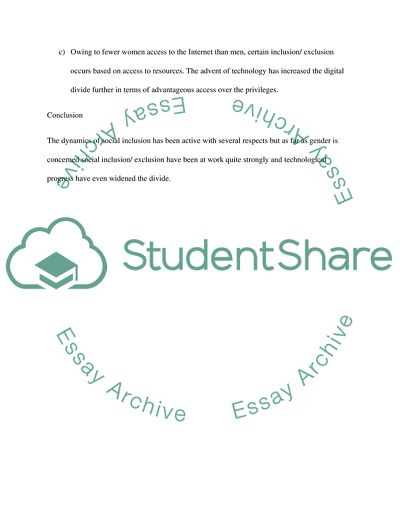Cite this document
(The Issue of Gender in Relation to Inclusion and Exclusion Essay, n.d.)
The Issue of Gender in Relation to Inclusion and Exclusion Essay. https://studentshare.org/sociology/1744424-how-are-weengenderedmale-and-femaleand-what-does-this-mean-in-relation-to-inclusionexclusion-in-certain-aspects-of-our-society-has-technology-changed-the-dynamics-in-terms-of-inclusionexclusion
The Issue of Gender in Relation to Inclusion and Exclusion Essay. https://studentshare.org/sociology/1744424-how-are-weengenderedmale-and-femaleand-what-does-this-mean-in-relation-to-inclusionexclusion-in-certain-aspects-of-our-society-has-technology-changed-the-dynamics-in-terms-of-inclusionexclusion
(The Issue of Gender in Relation to Inclusion and Exclusion Essay)
The Issue of Gender in Relation to Inclusion and Exclusion Essay. https://studentshare.org/sociology/1744424-how-are-weengenderedmale-and-femaleand-what-does-this-mean-in-relation-to-inclusionexclusion-in-certain-aspects-of-our-society-has-technology-changed-the-dynamics-in-terms-of-inclusionexclusion.
The Issue of Gender in Relation to Inclusion and Exclusion Essay. https://studentshare.org/sociology/1744424-how-are-weengenderedmale-and-femaleand-what-does-this-mean-in-relation-to-inclusionexclusion-in-certain-aspects-of-our-society-has-technology-changed-the-dynamics-in-terms-of-inclusionexclusion.
“The Issue of Gender in Relation to Inclusion and Exclusion Essay”. https://studentshare.org/sociology/1744424-how-are-weengenderedmale-and-femaleand-what-does-this-mean-in-relation-to-inclusionexclusion-in-certain-aspects-of-our-society-has-technology-changed-the-dynamics-in-terms-of-inclusionexclusion.


